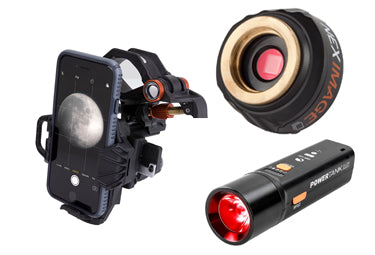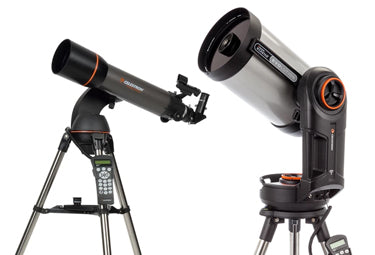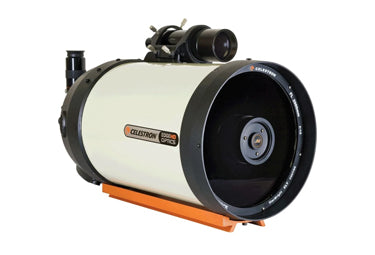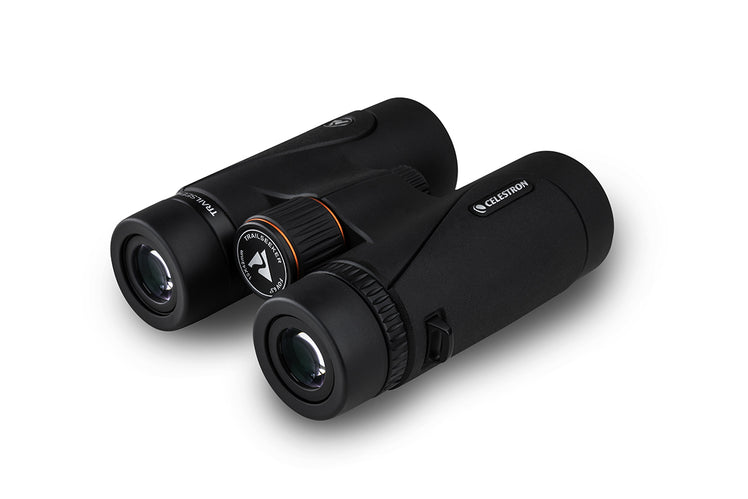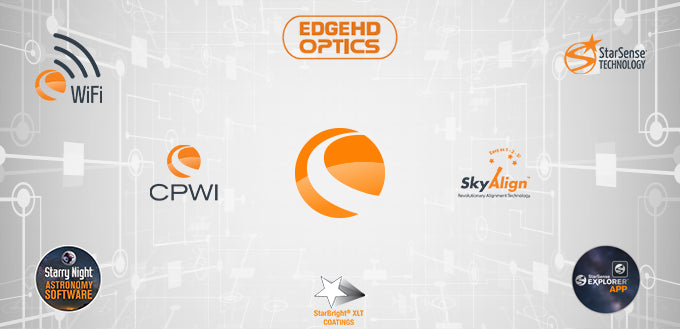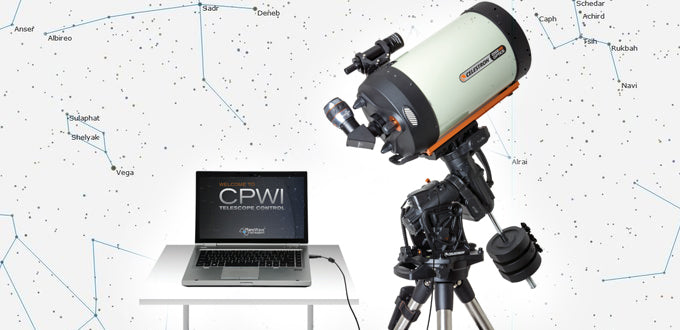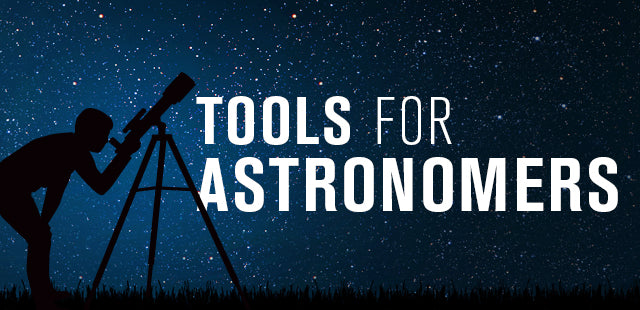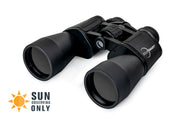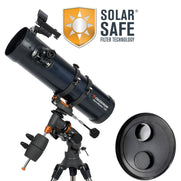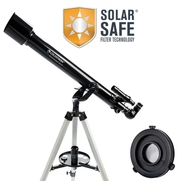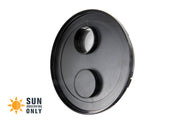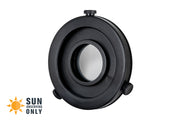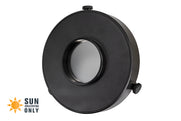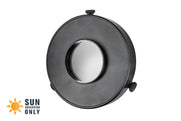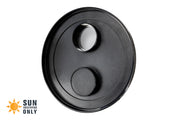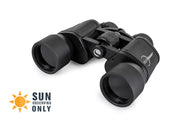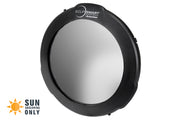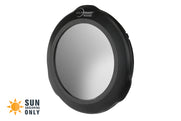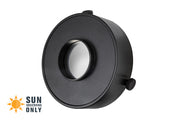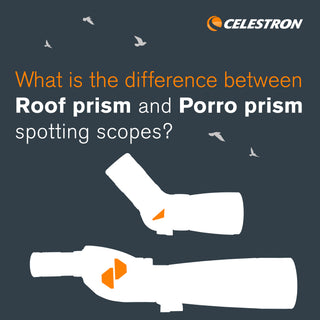The Ultimate Guide to Observing the Sun
May 28, 2021
 “Here comes the Sun, and I say, ‘It’s all right.’” Do these catchy lyrics sound familiar? "Here comes the Sun, and I say, 'It's all right.'" Sound familiar? These classic Beatles lyrics resonate with listeners worldwide, symbolizing hope, renewal, and the promise of a new beginning. Each morning, we count on the Sun to rise in the east, draping our world in light and warmth. The Sun is always there, our faithful companion in the sky, shining brightly or hidden behind clouds.
“Here comes the Sun, and I say, ‘It’s all right.’” Do these catchy lyrics sound familiar? "Here comes the Sun, and I say, 'It's all right.'" Sound familiar? These classic Beatles lyrics resonate with listeners worldwide, symbolizing hope, renewal, and the promise of a new beginning. Each morning, we count on the Sun to rise in the east, draping our world in light and warmth. The Sun is always there, our faithful companion in the sky, shining brightly or hidden behind clouds.
If you're fascinated by mythological tales or just grateful for warm morning rays, the Sun has an extraordinary story to share. This blog invites you to learn about captivating facts, explore cultural legends, and gain practical tips to be aware of while observing our nearest star. Let's celebrate our celestial neighbor and learn to embrace its brilliance safely.
Major Solar Events in 2025
Partial Solar Eclipses:
- March 29, 2025: A partial solar eclipse occurred in parts of the Northeastern United States, Eastern Canada, Greenland, Europe, Northwest Africa, and northwestern Russia. At its peak, it reached a magnitude of 93.76% coverage.
- September 21, 2025: A partial solar eclipse will occur in New Zealand and parts of Antarctica. Partiality will be visible across much of Oceania. At its peak, it will reach a magnitude of 85.5% coverage.
Solar Maximum of Cycle 25:
Solar Cycle 25 officially reached its maximum phase in 2025, marking the most intense period of solar activity in the current 11-year cycle. The Sun's behavior gradually intensified over the preceding years, culminating in a peak period with elevated sunspot counts, powerful solar flares, and frequent magnetic storms.
- Although scientists originally forecasted a modest peak around mid-2025, the Sun ramped up earlier than expected. By August 2024, sunspot numbers had surpassed predictions, suggesting a stronger-than-anticipated cycle. Scientists believe Cycle 25 may exhibit a dual peak, where solar activity surges twice during the maximum phase, as seen in Cycle 24.
- The X9.0 solar flare of October 2024, the strongest of the cycle, triggered vivid auroras visible as far south as California, Florida, and Mexico.
- Thanks to solar missions like NASA's Parker Solar Probe and the Solar Orbiter, scientists are capturing real-time data that's helping them unlock the mysteries of space weather and its effects on Earth.
A Star Enshrouded in Lore
The Sun, known by its Latin name Sol, has long been a central figure in human culture, mythology, and religion. Here are some ancient myths:
- In ancient Egypt, Ra, the Sun God, played a major role in religion and royal life, though he was one of many gods worshipped. Ra sailed across the sky in a boat by day and through the underworld by night.
- The Aztecs believed the Sun required human sacrifices to sustain its journey across the sky, honoring deities like Huitzilopochtli and Tezcatlipoca.
- In Hawaiian legend, the demigod Maui slowed the Sun's journey across the sky so his mother, Hina, would have more time to dry her clothes, gifting humanity longer days.
- In Norse mythology, the Sun goddess Sol is chased through the sky by a wolf named Sköll. Eclipses were believed to occur when Sköll got close to bite the Sun.
What is the Sun?
The Sun is a star at the heart of our Solar System. While it's not fundamentally different from other stars scattered across the night sky, it appears unique to us simply because of how incredibly close it is to Earth. This enormous, glowing sphere is composed primarily of hydrogen (about 91%) and helium (around 8.9%), with trace amounts of heavier elements like carbon, nitrogen, and oxygen. Due to its extreme temperatures, these elements exist in a highly energized, gas-like state known as plasma.
The Sun formed roughly 4.6 billion years ago, originating from a dense region of gas and dust within a spiral arm of the Milky Way galaxy called the Orion Spur.
Classified as a main-sequence star, specifically a yellow dwarf, the Sun continuously generates energy through nuclear fusion in its core, powering life on Earth and shaping our planetary system.
Like Earth, the Sun has distinct layers but no solid surface. The three inner layers produce their energy, and the four outer layers form their gaseous atmosphere, surrounding it like a protective jacket. Its seven layers, moving from the outermost to the innermost, are:
- Corona: The Sun's Crown or Corona is the outermost layer seen during a total solar eclipse. It is mysteriously hotter than the Sun's Photosphere. Its temperature ranges from 1 to 3 million °C (1.8 to 5.4 million °F).
- Transition Region: A narrow zone between the chromosphere and corona.
- Chromosphere: A thin, reddish layer of a star's atmosphere between the photosphere and corona.
- Photosphere: The star's visible surface from which most light escapes into space. It's a thin layer of hot gas, about 500 km thick, where temperatures hover around 5,500 °C or 9,932 °F. It's the coolest layer of the Sun's atmosphere.
- Convective Zone: The outer layer of a star's interior, where hot plasma rises, cools, and sinks, creating convection that causes the Sun's grainy surface.
- Radiative Zone: The layer of a star's interior outside the core, where energy travels outward as electromagnetic radiation.
- Core: The star's central powerhouse, where nuclear fusion transforms hydrogen into helium, releases energy that fuels its light and heat. It's the hottest and densest region, soaring to 15 million °C or 27 million °F!
The Sun's intense gravitational pull keeps all eight planets, as well as dwarf planets, asteroids, comets, and meteoroids, bound in orbit. Without the Sun's gravitational anchor, these objects might never have formed or would have drifted aimlessly through space.
The Solar Cycle: A Rhythm of Solar Activity
The Sun follows a recurring cycle of activity known as the solar cycle, transitioning between periods of relative calm and bursts of intense solar phenomena. Approximately every 11 years, the Sun undergoes a magnetic polarity reversal, where its north and south magnetic poles swap positions.
Cycle Highlights:
- The Sun's outer layers—photosphere, chromosphere, and corona—shift from quiet states to heightened activity.
- Common features include sunspots, solar flares, and coronal mass ejections (CMEs), which can impact space weather and Earth's magnetic field.
- Solar cycles typically last 8 to 14 years, varying intensity levels from one cycle to the next.
Solar Minimum:
- A period marked by low solar activity, with few sunspots and rare flares.
- Some days may pass with no observable solar disturbances.
Solar Maximum:
- The peak phase of the solar cycle features frequent solar storms.
- This surge includes numerous sunspots, flares, prominences, and CMEs, offering spectacular space weather events.

Sun Facts
- The Sun is approximately 4.603 billion years old. Astronomers believe it’s about halfway through its lifespan.
- It’s the largest object in our Solar System, comprising 99.8% of the system’s mass.
- The Sun is composed of 91% hydrogen, 8.9% helium, and smaller amounts of oxygen, carbon, iron, neon, and other elements.
- The Sun is in the center of our Solar System with Earth orbiting 93.603 million miles away—a distance also known as 1 AU (astronomical unit).
- Sol is a medium size star classified as a yellow dwarf. There are many stars in the Universe that are larger and smaller than our Sun.
- The Sun's magnetic field spreads throughout the Solar System by the solar wind.
- The Sun’s hot plasma take the shape of a near perfect sphere with a diameter of 865,370 miles.
- It takes eight minutes for light to travel from the Sun to the Earth. This distance is the basis for establishing the speed of light.
- The Earth and Sun’s interactions result in seasons, ocean currents, climate, and the auroras (northern/southern lights).
- 3 million Earths would fill the Sun’s interior if it were hollow.
- The solar surface temperature is 10,000 degrees Fahrenheit. Temperatures can reach more than 27 million degrees Fahrenheit within the core.
- Inside the Sun, hydrogen atoms, under high pressure from gravity, go through a process called nuclear fusion and are converted into helium atoms. This process generates an immense amount of heat, causing radiation and sunlight to reach the Earth.
- A Coronal Mass Ejection (CME) is an explosive outburst of billions of tons of super-heated plasma from the Sun. When CMEs hit the Earth, our atmosphere usually protects us, and the Earth’s magnetic field deflects the electrified plasma to the north and south poles where they light up the night sky as auroras. If a CME penetrates the magnetosphere, it has the potential to wreak havoc on the power grid, satellites, electrical and communications equipment and more!
- The Sun is labeled as a G-type main-sequence star or G2V.
- There are billions of stars in the Milky Way Galaxy, but the Sun is the most important star and energy source for Earth and its inhabitants.
- Like all the planets, the Sun rotates on its axis. One solar day lasts about 27 Earth days. It spins fastest at its equator, where it takes about 24 days to rotate. The poles take more than 30 days.
- The Sun’s gravitational force is so strong that it can hold all eight planets, many dwarf planets, at least 170 moons, and countless comets, asteroids, and meteors in its orbit.
- The Sun emits different forms of electromagnetic radiation: visible light, infrared, and ultraviolet rays, which make up 99% of these radiations.
- When it uses up its supply hydrogen and helium and nears the end of its lifespan, the Sun will expand and swallow up the inner planets. It will then collapse and become a white dwarf.
- Sunlight consists of all the colors mixed together but appears white to our eyes.
- From the Northern Hemisphere, Earth is farthest from the Sun in July and is closest to the Sun in January!
How to Safely Observe the Sun
The Sun's shimmering brilliance may captivate us, but it's also a powerful source of ultraviolet and infrared radiation. Staring at it without proper protection can cause irreversible retinal damage, even blindness. Fortunately, with the right tools and precautions, solar observing can be safe and awe-inspiring.
Safety Matters
Gazing at the Sun without certified protection risks:
- Permanent vision loss or retinal burns
- Invisible injuries (because the eyes lack pain receptors)
- Heat damage to equipment and optics
Rules of Safe Solar Viewing
To enjoy the Sun without harm:
- NEVER look directly at the Sun without a certified solar-safe filter.
- NEVER use sunglasses, camera lenses, or other improvised filters, as they offer no real protection.
- ALWAYS use solar filters that meet the ISO 12312-2 standard.
- Inspect filters for damage before each use and discard any with scratches, holes, or defects.
Equipment Dos and Don'ts
- Use certified solar filters that cover the full front aperture of your telescope or binoculars.
- Avoid filters that screw into the eyepiece, as heat buildup can crack glass and injure your eyes.
- Don't use optics to project the Sun's image onto a surface, it can damage equipment or injure viewers.
- Remove or cover your finderscope to prevent accidental exposure and damage to crosshairs.
Supervision and Awareness
- Closely monitor children while they view the Sun, even while they use protective equipment.
- NEVER leave solar-viewing equipment unsupervised, especially in group or public settings.
Dangerous Materials to Avoid
Do NOT use the following as solar filters:
- Black-and-white or color negatives
- Exposed film, X-rays
- Smoked glass, neutral density, or polarizing filters
- Stacked sunglasses
While they appear to dim the Sun's light, they still allow dangerous levels of infrared radiation to pass through, causing severe eye damage.
With these precautions, solar viewing can be a safe and thrilling exploration of our closest star. Grab your certified gear and enjoy the Sun's spectacle—your eyes will thank you.
For more information on solar safety, check out this video:
For other important solar safety videos, click here.
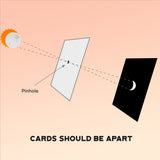 |
Pinhole Projection Time-tested and proven safe, this is a great indirect method for observing the Sun, especially during solar eclipses. Take two pieces of cardboard or paper plates and punch a tiny hole in one to allow sunlight to pass through onto the other card. The further you separate the cards from each other, the larger the image scale will be, but the solar image will be dimmer. |
 |
Interlacing Fingers No additional equipment is required for this indirect viewing method. Just interlace your fingers, leaving small gaps between them. Standing with your back towards the Sun, allow sunlight to pass through your fingers and onto the ground. During the partial phases of a solar eclipse, you can see tiny crescents being projected. |
 |
Tree Leaves Yet another indirect method to view the partial phase of a solar eclipse is to allow nature to play a role. Sunlight filtering through tree leaves will leave countless crescent Sun images on the ground or a wall. You will see many circle-like shadows with bright rings during an annular eclipse at maximum coverage. It truly is a sight to see! |
 |
TV/Internet The safest way to watch a solar event, such as a solar eclipse, is to view the event on your TV or computer in the comfort of your home or office. Many news outlets will broadcast the event safely for all to see and in much higher resolution with expert commentary. |
 |
Arc Welder’s Glass Moving into direct solar viewing methods, one of the most widely available filters for safe solar viewing is shade number 14 welder's glass (darkest grade), which can be obtained from any welding supply outlet (source: NASA Eclipse Website). Please note that the Sun's image through the #14 welder's glass will appear green. |
 |
White Light Solar Filters A white light solar filter, which works in the visible spectrum, is an ideal way to turn a nighttime astronomical telescope into a daytime solar observing telescope. It is designed to view the solar photosphere and sunspots. Solar filters can be metal on glass (most durable and costly), aluminized polyester film (also known as aluminized Mylar), and polymer. Filters can be easily attached to the front cell of different types of optical telescopes and come in all different sizes that lock into place or are snug-fitted. Celestron's EclipSmart 60 and 70mm refractor solar filters have set screws in the side of the filter housing to grab onto the lens shade for a secure fit, while the 5", 6" SCT, and 8" SCT and EdgeHD solar filters are snug-fitted but also come with Velcro straps for added security. Each EclipSmart solar filter provides a more natural orange solar disk view and features scratch-resistant polymer from American Paper Optics. They feature Solar Safe filter technology, the ultimate protection from harmful solar radiation, including IR and UV light, and filter 99.999% of visible light . |
 |
Solar Eclipse Glasses Solar eclipse glasses, such as Celestron's EclipSmart Solar Safe Shades, are easy to wear and feature Solar Safe filter technology for the ultimate protection from harmful solar radiation, including IR and UV light, and 99.999% of visible light. They provide a more natural orange solar disk view and are perfect for solar viewing anytime or viewing a solar event, such as the partial phase during a solar eclipse. Solar glasses should never be used as solar filters for a telescope . |
 |
Solar Safe Binoculars Celestron's EclipSmart Solar Binoculars are small, compact, and easy to transport while traveling to a solar eclipse viewing location. It's an ideal white-light solar viewing binocular that provides a full magnified view of the entire solar disk. It features Solar Safe filter technology for the ultimate protection from harmful solar radiation, including IR and UV light, and 99.999% of visible light. |
 |
Dedicated White-Light Solar Telescope Celestron's EclipSmart Travel Solar Scope 50 is a dedicated white-light solar scope for the observer on the go. It's lightweight, compact, and easy to transport while traveling to a solar viewing event. It is an ideal solar telescope to view the solar photosphere and sunspots. The 50mm refracting solar scope uses Celestron's Solar Safe, ISO compliant, full-aperture glass filter material to ensure the safest view of any solar event. This solar scope offers much higher magnifications for viewing sunspots or planetary transits than you would otherwise get using solar eclipse glasses or binoculars. |
 |
Dedicated H-alpha Solar Telescope A unique and exciting way of observing the Sun is through a telescope designed to observe the H-alpha emission produced by hydrogen. Observing the chromosphere requires a narrow bandwidth filter centered on the H-Alpha spectral line of 6562.8 angstroms. The views through an H-alpha telescope make the Sun come alive with incredible detail not seen in a telescope using a traditional white light solar filter. By "tuning" the scope's etalon, fine adjustments can be made to the bandpass of appropriate wavelengths to see prominences and surface detail since the frequency can be shifted due to "blue shifting". Granule markings can be seen on the Sun's surface, while spiky prominences can appear to jet out into space and then disappear over time. Dark filaments can appear like snakes, while bright, whitish markings called faculae can also be seen before sunspot appearances. Several third-party H-alpha telescope manufacturers offer these specialized solar telescopes, which can be quite expensive. |
See the full line up of Celestron EclipSmart Products
EclipSmart solar products feature Solar Safe filter technology, providing the ultimate protection from harmful solar radiation, including IR and UV light, and 99.999% of visible light. Celestron Solar Safe filter technology is GUARANTEED SAFE for direct solar observation and has been independently tested by SAI Global Assurance Services. Solar Safe products conform to and meet the transmission requirements of ISO 12312-2, Filters for Direct Observation of the Sun, EN 1836:2005 + A1:2007 (E) for an E15 Filter for the Direct Observation of the Sun, and AS/NZS 1338.1:2012, Filters for Eye Protectors.
Solar Observing Targets
 |
Sunspots Sunspots are cooler, darker regions on the Sun's bright surface, known as the photosphere. They are caused by intense magnetic activity within the Sun and typically occur in pairs with opposite magnetic polarity. Most sunspots feature a central dark region called the umbra, surrounded by a lighter, filamentary area known as the penumbra. Sunspots are dynamic, they slowly drift across the solar surface and can change in size and shape over time. Some are large enough to be seen without magnification using safe solar viewing glasses. Sunspots reveal intricate structure and fine detail when observed through a telescope equipped with a white light solar filter. Their appearance and frequency follow an approximately 11-year solar cycle, during which solar activity waxes and wanes. |
 |
Granules Granules appear like small bubbles you would see rising to the top in a kettle of boiling water. They are small (approximately 900 miles in diameter), and their textured appearance results from hot gas continuously rising from the Sun's core. Granules are the tops of convection cells that spread across the solar surface, cool, and sink back down. They last about five to ten minutes and are best seen using high power in good seeing conditions. They are superb to view in an H-alpha solar telescope. |
 |
Limb darkening A phenomenon where the edge of the Sun's disk appears dimmer than its center. This effect is observed using a telescope equipped with a white-light solar filter. At the center of the disk, your line of sight penetrates deeper into the Sun's photosphere, revealing hotter, denser gas that emits more light. Toward the edge or limb, you're viewing shallower layers of the photosphere, where the gas is cooler and thus appears darker. This gradient in brightness is evidence that the Sun has a layered atmosphere. Limb darkening is especially pronounced in astrophotography, but it's also clearly visible with proper solar viewing equipment. |
 |
Faculae
|
 |
Prominences Solar prominences are one of the most dramatic solar phenomena to observe through an H-alpha telescope or with your eyes during the total phase of a solar eclipse. They are towering structures of hot gases of electrically charged hydrogen and helium, often in glowing red loops. Prominences are expelled hundreds of thousands of miles into space and into the solar corona, where they can reside for several weeks or months. They form in about a day and are anchored in the photosphere. You can safely observe prominences with the naked eye only during totality, when the Moon completely blocks the Sun's extremely bright photosphere. Eye protection must be used as soon as totality is over. However, with an H-alpha telescope, you can view solar prominences any time they erupt, thanks to the scope's specialized hydrogen narrow bandwidth filter. |
 |
Filaments |
Special Solar-related Phenomena to Explore
Observers starting in amateur astronomy may limit themselves to nighttime objects like the Moon, planets, bright star clusters, and nebulae as celestial observing targets. But did you know that the Sun is also responsible for many solar-related phenomena that can be enjoyed during the daytime, right from your backyard? Of course, remember to follow the solar observing rules above and protect your eyes at all times.
 |
Eclipses |
 |
Solar Transits A solar transit occurs when any object passes between the Sun and the Earth and appears as a black disk moving across the face of the Sun, including the International Space Station! The two inner planets, Mercury and Venus, are well known for transiting the Sun, which can take several hours. Mercury last transited the Sun on May 7, 2003; November 8, 2006; May 9, 2016; and November 11, 2019. The next transit will occur on November 13, 2032. Venus transits are much rarer and occur in a pattern that repeats every 243 years. The last transit of Venus took place on June 5-6, 2012, and was the last Venus transit of the 21st century. The next Venus transit will occur on December 10-11, 2117, and December 8, 2125. |
 |
Green Flash The elusive green flash is a meteorological optical phenomenon that sometimes occurs during sunrise or sunset when optical conditions are just right. Some eagle-eyed photographers may see the distinct green "flash" of light visible just above the upper rim of the Sun's disk that lasts about two seconds. Patience and good luck are required to spot the green flash. It is never recommended to stare directly at the Sun, even when the Sun sets, without proper eye protection. |
 |
Rainbows Of all the sky phenomena, rainbows are the most well-known. Seen often after a rainstorm, rainbows are produced as sunlight strikes water droplets in the air that act like prisms, dispersing the light and separating the colors. Rainbows are a circular arc and only occur opposite the Sun. The lower the Sun is towards the horizon, the higher a rainbow can be seen in the sky. Rainbows are full circles and can be seen in full form from the air if conditions are right. But for ground observers, the horizon will limit the view. Primary rainbows are always seen with red on the outer band with violet on the inner band. A secondary or double rainbow may sometimes appear because light is reflected twice inside water droplets. In this case, a secondary arc can be seen outside the primary rainbow's arc. The colors will be reversed with violet on the outer band and red on the inner band. |
 |
Sun Dog A sun dog is a concentrated spot of sunlight about 22 degrees to the left or right of the Sun. Sun dogs usually form in pairs on either side of the Sun, usually when it's lower in the sky. They can occur when sunlight refracts through icy cirrus clouds containing hexagonal plates during cold weather. These crystals act as prisms that bend light rays passing through them. As the crystals sink through the air, they become vertically aligned and refract sunlight horizontally to create the appearance of sun dogs, also known as phantom Suns. They can be colorful like a rainbow. Rainbows are seen looking away from the Sun, while sun dogs look towards the Sun. |
 |
Solar Halo A solar halo appears as a white circle that forms a ring around the Sun. You can see them at any time of the year. Like a lunar halo, the halo is created when sunlight passes through ice crystals within high-altitude cirrus clouds. It has a radius of 22 degrees. Unlike sun dogs, which appear on both sides of the Sun when it's lower in the sky, a solar halo can be visible when the Sun is higher or lower in the sky. |
 |
Sun Pillar A sun pillar appears as a beam of light that forms when sunlight reflects off the surfaces of ice crystals associated with thin, high-level clouds such as cirrostratus clouds. It can reach five to ten degrees high while the Sun is low in the western sky before sunset, or low in the eastern sky just after dawn. Sun pillars can even be seen while the Sun is below the horizon. |
 |
Aurora Named after the Roman goddess of the dawn, the Aurora Borealis is the northern lights in the Northern Hemisphere, while the Aurora Australis is the southern lights in the Southern Hemisphere. Auroras usually appear green or white, but can also exhibit colors like blue, red, and even pink. Auroras can dance, change shape, appear dim as thin clouds, or be bright enough to light up the landscape. Auroras form when the Sun's solar wind is ejected into space and directly into Earth's path. The Earth has a magnetic field called the magnetosphere that deflects most of the solar particles, but some make it through, evoking oxygen and nitrogen atoms that light up, producing a spectacular and colorful light show near locations by the poles. |
 |
Glory Look out the window the next time you're on an airplane to spot this neat effect. Look for the plane's shadow projected onto clouds and surrounded by a multi-colored circle of lights. This circle is called a glory. It is always located opposite the Sun and is caused by the deflection of sunlight hitting tiny water droplets in the clouds. |
 |
Zodiacal Light The zodiacal light is a diffuse, triangular, whitish glow seen at the sunrise or sunset points on the horizon before dawn breaks or after twilight ends. It can extend from the horizon along the zodiac and straddle the ecliptic. The zodiacal light is caused by sunlight scattered by interplanetary dust. Your best chance of seeing this rare occurrence is during twilight after dusk in spring and before dawn in fall when the zodiac is at a steep angle to the horizon. Because the zodiacal light can be faint, moonlight or city lights can make it difficult to spot. |
Helpful Observing Hints
|
Tip #1:  |
Today's most modern and informative tools are in astronomy apps such as Celestron's SkyPortal Powered by SkySafari™ Mobile App. This full-featured planetarium app is included with the purchase of any Celestron telescope, available from the Apple App Store or Google Play. SkyPortal instantly provides new telescope owners with a wealth of information, including audio and written descriptions about various objects, including the Sun. It also provides celestial coordinates, a real-time sky map, rise and set times, and physical and orbital parameters. |
|
Tip #2:
|
Steady seeing conditions are critical while observing objects such as the Sun, Moon, planets, or double stars, although deep sky objects such as nebulae and galaxies are less affected by poor seeing conditions. Avoid times of bad seeing when our atmosphere is turbulent, and your targets appear like shimmering blobs in your telescope's eyepiece. Start with low magnification and work up if the views remain steady. You will be amazed at how sharp and detailed solar features can appear during good seeing. |
|
Tip #3: |
Please set up your telescope outside and let it acclimate to the outside temperature before solar observing to avoid distorted views. |
|
Tip #4:
|
Collimate, collimate, collimate! If you own a Newtonian or Schmidt-Cassegrain telescope, ensure your telescope's optics are collimated. It can make a difference when it comes to discerning fine solar detail. If the optics are slightly out of alignment, you may cheat yourself from seeing the clearest and sharpest images. |
Final Thoughts
We're lucky to orbit a star that gives us everything we need to survive, from warmth and light to the cycles that shape our climate and seasons. The Sun does more than light up our mornings and provide stunning sunsets; it plays a key role in shaping our lives and natural rhythms. It's a steady, powerful force that affects nearly every part of our world, which we sometimes take for granted. Although there are billions of stars in the Milky Way galaxy, our Sun is special and belongs to all of us.
While solar events can be incredible to witness, they also come with risks, and extra caution should always be taken. Always use certified solar filters when observing the Sun, especially with children involved. With proper, safe, and approved solar filters in place, the Sun can provide us with a lifetime of viewing enjoyment. Just don't forget to wear your hat and bring plenty of sunscreen!
To explore Celestron's full range of solar products—including telescopes, binoculars, and accessories—visit Celestron.com/EclipSmart
Clear skies and happy observing!
Other articles you might be interested in: Ultimate Guide to Observing the Universe

